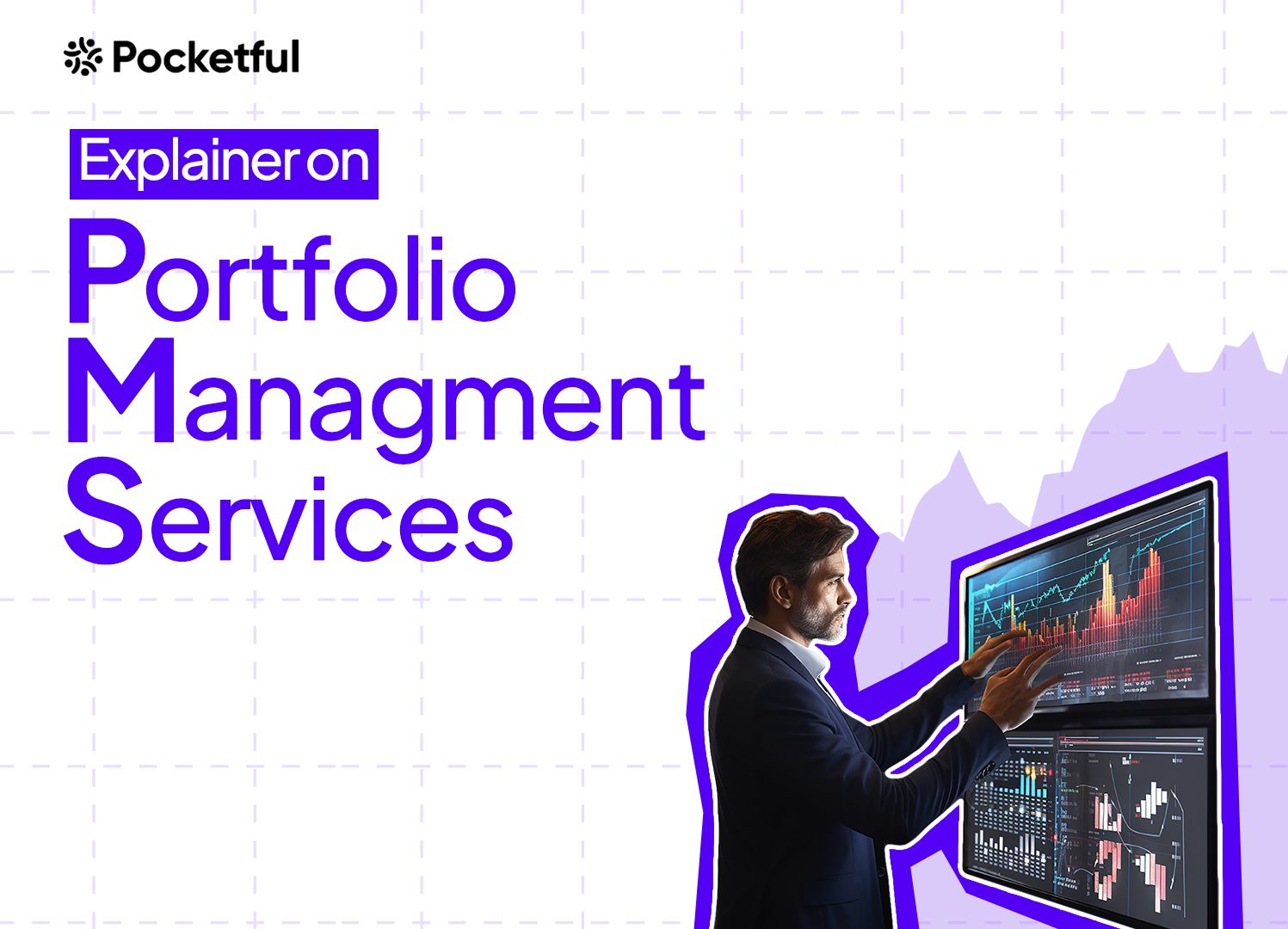| Type | Description | Contributor | Date |
|---|---|---|---|
| Post created | Pocketful Team | Mar-07-24 | |
| Add internal links | Nisha | Feb-24-25 |

- Blog
- explainer on portfolio management services pms features types charges taxation and risks
Explainer on Portfolio Management Services (PMS): Features, Types, Charges, Taxation, and Risks

If you have accumulated significant wealth during your career and wish to seek professional help in managing the funds, then Portfolio Management Services (PMS) can prove helpful to you.
Today’s blog will focus on individuals who wish to gain more profound knowledge of Portfolio Management Services (PMS).
Portfolio Management Services Overview
Portfolio management services, or PMS, is a financial service offered by financial institutions. This service primarily focuses on investing investors’ funds with a larger portfolio than the average individual. Such investors can invest their money in this service, and a team of qualified fund managers will allocate it to various asset classes based on their investment goals.
Typically, investors allocate a portion of their portfolio to equity but cannot manage it effectively due to a lack of professional knowledge. This is where PMS comes in; with a minimum investment of 50 Lakhs, your entire investment amount will be given to a portfolio management company, and their team of seasoned professionals will allocate it among various asset classes based on market and economic conditions. In exchange, they will charge a fee for their services.
The first announcement of the SEBI regulation for PMS dates back to 1993. All Portfolio Management Companies are required to adhere to the compliance standards established by SEBI.

Minimum Investment Amount
Over time, PMS’s minimum investment amount has undergone modifications. The PMS legislation was first established in 1993, with a minimum investment value of 5 lakh. In 2012, the minimum investment amount was raised to 25 lakh; in November 2019, it was further increased to 50 lakh.
Features of PMS
1. Investment in PMS provides customized solutions as per investors’ objectives.
2. The fund managers have vast experience in managing funds
3. PMS fund managers generally diversify the investment across different asset classes, ultimately lowering the risk.
4. Reports like transactions, profit and loss, etc., will be sent periodically to investors, and they can also check the same on the online platform provided by PMS companies.
5. PMS is a product with a minimum ticket value of 50 lakhs, which is generally suitable for HNI investors.
Read Also: Explainer on Cigar Butt Investing: Features, Advantages, Limitations, and Suitability Explained
Types of PMS
A financial institution offers a variety of portfolio management services, including
1. Discretionary Portfolio Management– The portfolio managers make all investment-related decisions under this category of portfolio management services on the client’s behalf. Before making any investments, the fund management is at liberty and is not required to confer with the investor. The majority of the clients choose this type of service.
2. Non-discretionary Portfolio Management– The fund manager must obtain the client’s confirmation before investing in this kind of service. The client receives financial advice from PMS’s investment team but ultimately decides whether or not to act on the advice.
3. Advisory Services – In this arrangement, a fund manager will merely offer advice to investors on various asset classes; the investor will decide whether to follow the fund manager’s recommendation.
4. Active Portfolio Management – The ultimate goal of active portfolio management is to maximize investor return, which is accomplished by actively allocating funds to various asset classes. The fund management actively chooses the allocation of funds and where to invest them.
5. Passive Portfolio Management – The fund manager uses this investment management technique to allocate the funds to stocks that track indexes and increase steadily over time.
Charges of PMS
The charges of PMS can be classified into 3 different categories-
Fixed Charges
This is what every PMS charges as its main fee. This is an ongoing charge that depends on the average value of your investment and varies from 1% to 3%. The fee is due regardless of the fund manager’s performance ratings. This is the minimum amount that must be paid to the PMS firm regardless of the fund’s performance.
Below is the illustrative table of the same.
| Fees | 2% |
| Investment Amount | 50,00,000 |
| Return on Portfolio | 20% |
| Profit | 10,00,000 |
| Portfolio Value at the year-end | 60,00,000 |
| Fixed Charges 2% | 1,20,000 |
| Net Value of Portfolio after Fees Adjustment | 58,80,000 |
Performance Based
The fund’s returns are used to determine these fees. The fund management will charge a fee based on the percentage of profit made above the minimum rate, also referred to as the hurdle rate.
We can better understand this by using an example. For example, if the hurdle rate is 8% the profit sharing ratio is 20% above the hurdle rate, and your investment of Rs. 50 lakh yields a 20% return on your portfolio, your total profit will be Rs. 10 lakh, of which Rs. 4 lakh is the minimum profit that needs to be delivered. The company will then charge a fee of 20% of the remaining profit of 6 lakhs.
Below is the illustrative table for the same.
| Fees | Profit Sharing – 20% above 8% Hurdle Rate |
| Investment Amount | 50,00,000 |
| Return on Portfolio | 20% |
| Profit | 10,00,000 |
| Value of Portfolio at the end of the year | 60,00,000 |
| Hurdle Rate 8% | 4,00,000 |
| Profit over hurdle rate | 6,00,000 |
| Profit Sharing 20% of 6,00,000 | 1,20,000 |
| Net Value of Portfolio after Adjustment | 58,80,000 |
Hybrid Fee Structure
This fee schedule combines a profit-sharing concept with a fixed fee. In this instance, the hurdle rate is typically higher than in a performance fee-based approach, and the fixed charge rate will be lower than in a fixed charge model. This is intended for PMS managers who wish to profit from both fee structures.
Taxation
Equity Taxation – If a portfolio is heavily weighted toward the equities asset class, the tax rate on the profit amount will be 15% if the holdings are sold within a year, and the appropriate rate will be 10% above 1 lakh if the holdings are sold after the year.
Non-Equity Taxation – The portfolio will be considered a short-term gain and included in the investor’s income at their slab rate if it is sold within three years and does not concentrate in the equity asset class. If the units are sold after three years, they will be considered a long-term gain and subject to a 20% tax with indexation benefit.
Dividend Income –All dividend income earned on the investment will be included in the investor’s income and taxable as per their tax slab.
Exit Load – If you withdraw your money before a predetermined amount of time, PMS firms typically charge an exit load, ranging between 1 to 3%.

Risks
The risks investors should consider before investing in PMS are listed below.
1. Performance of Fund Manager – Evaluating the fund manager’s performance before investing is essential. Looking for a fund manager with a stable track record is usually advisable.
2. Market Risk – Due to the investment’s significant exposure to the equities asset class, there is a greater chance of losses and a rise in portfolio volatility.
3. Liquidity Risk – Because certain illiquid securities are difficult to sell, investing in them may affect your portfolio liquidity.
4. Regulatory Risk – As previously stated, the minimum ticket size for investing in PMS has increased from 25 lakhs to 50 lakhs in 2019. Future legislative changes of this nature could affect PMS’s investment strategies and tax consequences.
Read Also: Explainer on Imitation Investing: Psychology, Advantages, Limitations, and Strategies
Conclusion
We’ve gone over the benefits and risks of investing in PMS with you; this service is for high-net-worth individuals (HNIs) who understand the risks involved in this kind of investing. Suppose an investor is willing to assume the risk of this product and is seeking a better return. In that case, they should consider all the important characteristics before making a decision.
Before making any investing decisions, we advise you to speak with your financial advisor to better understand your ability to accept risk.
Frequently Asked Questions (FAQs)
Is PMS investment permissible for NRIs?
Yes, You can invest in PMS as an NRI.
How do I access my PMS portfolio valuation?
In addition to sending clients statements regularly, PMS businesses offer their clients an online portal through which they can monitor their assets, transaction statements, and profit and loss statements.
How can you evaluate PMS performance before purchasing?
Before purchasing PMS, you can evaluate its performance by comparing its returns to the appropriate benchmark and examining the consistency of its returns over an extended duration.
Does PMS have a lock-in period?
PMS offers the flexibility of no lock-in period. However, redeeming your investment before the allotted time will incur an exit load.
Is there a guaranteed return in PMS?
No, PMS company cannot provide investors with a guaranteed rate of return.
Disclaimer
The securities, funds, and strategies discussed in this blog are provided for informational purposes only. They do not represent endorsements or recommendations. Investors should conduct their own research and seek professional advice before making any investment decisions.